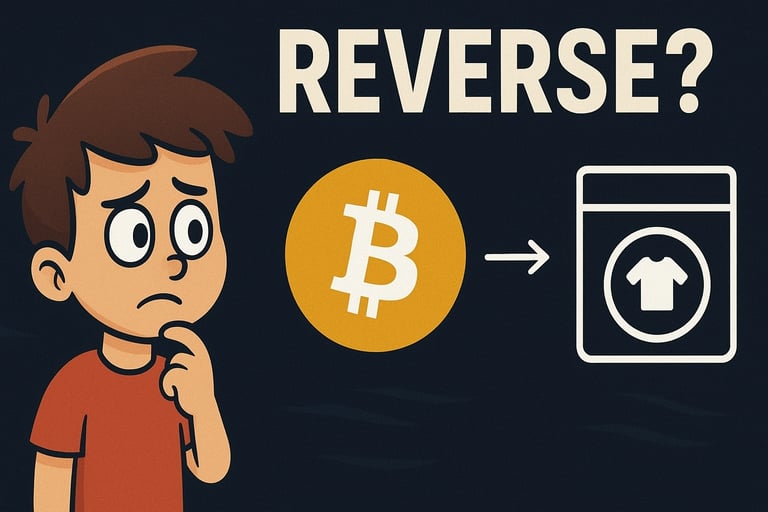Can You Reverse a Crypto Transaction in 2026? – The Ultimate Drop Finder Guide
Find out if crypto transactions can be reversed in 2026. Drop Finder explains why blockchain transfers are irreversible, how to recover lost funds, and how to prevent mistakes and scams.
CRYPTO NEWSLATEST AIRDROP
10/6/20256 min read
Can You Reverse a Crypto Transaction in 2026? – Complete Guide by Drop Finder
In the world of digital finance, cryptocurrency transactions are like carving your signature into digital stone — once it’s done, it’s permanent. Whether you sent Bitcoin to the wrong address, got scammed out of your USDT, or made a simple typo in a wallet ID, one question echoes across the crypto space:
👉 Can I reverse my crypto transaction?
Let’s explore this in full detail — how blockchain transactions work, what makes them irreversible, and what real options you have if your crypto goes to the wrong place.
Drop Finder breaks it all down for you.
🧱 1. The Foundation — Why Crypto Transactions Are (Mostly) Irreversible
Unlike traditional banking systems, crypto transactions don’t rely on intermediaries like banks, card processors, or PayPal. Instead, transactions are verified and recorded by a decentralized blockchain network of nodes and miners.
Every transaction that occurs is:
Cryptographically signed
Time-stamped
Added to an immutable public ledger
Once confirmed, there’s no “undo” button.”
This immutability is what gives crypto its strength — it prevents double-spending, forgery, and censorship. But that same power also makes human errors and scams much harder to fix.
Think of it this way:
Sending Bitcoin to the wrong address is like sending cash through a sealed pipe — if it leaves your end, there’s no return valve.
🪙 2. Why Banks Can Reverse Transactions But Blockchains Can’t
In traditional finance:
A bank controls your account and has legal and technical authority to reverse transfers.
Credit card companies can process chargebacks.
Payment gateways can freeze and refund disputed funds.
But in blockchain:
No single entity has control over your funds once they’re broadcasted.
Your crypto wallet is self-custodial — only you (and your private key) can access it.
The blockchain protocol doesn’t recognize “mistakes,” “fraud,” or “disputes.”
In short:
Traditional money = centralized authority.
Crypto = code-based self-responsibility.
That’s the price of financial freedom — you are your own bank.
⚙️ 3. What Happens Technically When You Send Crypto
Understanding how a crypto transaction works helps explain why it can’t be reversed.
Here’s the simplified process:
You create a transaction request using your wallet.
Your private key signs the transaction, verifying it’s you.
The transaction is broadcasted to the blockchain network.
Miners or validators confirm and record it in a block.
Once confirmed, it becomes a permanent part of the ledger.
After confirmation:
It’s visible to everyone on the blockchain explorer.
It’s validated across thousands of nodes.
It cannot be altered without rewriting the entire chain — which is computationally impossible for large networks like Bitcoin or Ethereum.
💸 4. Common Situations Where People Want to Reverse Crypto Transactions
Let’s look at real-life cases where people wish reversal was possible — and what can (or can’t) be done in each scenario.
4.1 Sent to the Wrong Wallet Address
This is the most common mistake. You copied an address wrong, or pasted the wrong one.
👉 Unfortunately, if the address exists, your crypto is gone.
There’s no central authority to reclaim it. Only the owner of that wallet can send it back — voluntarily.
If you sent it to an unassigned or invalid address, the crypto is lost forever.
4.2 Sent to the Wrong Network
For example:
You sent USDT (ERC-20) to a TRC-20 address.
Or you transferred BNB (BEP-20) to an Ethereum address.
👉 Some exchanges (like Binance, OKX, KuCoin) may help recover cross-chain transfers if the destination address belongs to them. But there’s no guarantee, and it may take weeks with verification fees.
If the receiving wallet doesn’t support that network, your tokens are likely unrecoverable.
4.3 Scams or Fake Projects
You joined a Telegram “airdrop,” clicked a phishing link, or transferred to a scam wallet.
Sadly, these are non-reversible. Blockchain transactions are final — and scammers count on that.
You can:
Report the wallet address to exchanges and blockchain analytics firms (like Chainalysis or TRM Labs).
File a complaint with the cybercrime cell in your country.
Track the stolen funds using blockchain explorers to flag them as “tainted” — which sometimes leads to freezing if they reach a centralized exchange.
But a direct refund is almost never possible.
4.4 Exchange or Platform Error
If the transaction happened within a centralized exchange, such as Drop Finder Exchange (hypothetically), Binance, or CoinDCX — and hasn’t yet been broadcasted to the blockchain — the platform might reverse it internally.
However, once the transaction is on-chain, it’s final.
🧭 5. What You Can (Actually) Do After a Wrong Crypto Transaction
While blockchain won’t undo your transfer, here’s what Drop Finder recommends to maximize your recovery chances:
Step 1 — Check the Transaction Status
Use a blockchain explorer:
Bitcoin: blockchain.com/explorer
Ethereum/USDT (ERC-20): etherscan.io
Tron/USDT (TRC-20): tronscan.org
BSC (BEP-20): bscscan.com
Search your transaction ID (TxID).
If it’s still pending, you might cancel or replace it with a higher gas fee (Ethereum only).
Step 2 — Contact Exchange Support
If you sent funds to an exchange wallet:
Raise a ticket immediately with the TxID and screenshots.
Use Drop Finder’s support template (provided in future admin tools).
Some exchanges can recover it (especially wrong-chain deposits), but this is manual and time-sensitive.
Step 3 — Contact the Receiver
If you know the wallet’s owner (e.g., a friend or merchant), politely request a refund.
Once the crypto arrives in their wallet, they must voluntarily send it back.
Step 4 — Report Scams
If funds were stolen, report to:
Local Cyber Crime Cell
FIR under IT Act (India)
Interpol’s Global Cybercrime Portal
Or platforms like Coinfirm, Elliptic, or Drop Finder’s scam database (future feature)
Step 5 — Mark the Address
You can label the scam wallet on explorers (Etherscan, Tronscan) so others are warned.
🔐 6. How to Prevent Irreversible Crypto Mistakes (Practical Tips)
Drop Finder emphasizes prevention — because reversal is rarely an option.
Here’s your crypto safety checklist for 2026:
✅ Always double-check wallet addresses. Copy-paste errors are deadly.
✅ Use the correct network (TRC-20, ERC-20, etc.).
✅ Send a test amount first (e.g., 1 USDT).
✅ Enable whitelisted withdrawal addresses on exchanges.
✅ Avoid links or “giveaway” airdrops shared on Telegram or Discord.
✅ Bookmark official exchange URLs.
✅ Use hardware wallets for long-term holdings.
✅ Store seed phrases offline.
With blockchain’s speed, even a few seconds of carelessness can cause permanent loss.
🌍 7. Are There Any Reversible Cryptos? (Partially, Yes!)
While Bitcoin and Ethereum are fully irreversible, some modern blockchain projects are experimenting with semi-reversible features.
Here are a few examples:
🪙 a) Algorand & Tezos
They allow smart contract-based controls that can freeze or claw back tokens in specific legal scenarios — mainly for regulated enterprise tokens.
💵 b) Stablecoins Like USDT & USDC
Tether (USDT) and Circle (USDC) can freeze or reissue tokens linked to stolen addresses.
They’ve done it many times — especially in cases of large hacks or blacklisted wallets.
However, this only applies to officially issued tokens and requires legal justification. Regular users can’t request a reversal themselves.
🧠 c) Smart Contract “Escrow” Transactions
In DeFi (Decentralized Finance), transactions through escrow contracts or multisig wallets can be designed to allow disputes or reversals before settlement.
For instance, NFT marketplaces or DeFi escrow tools often hold funds until both parties confirm the trade.
Still, once the transaction is executed and confirmed, it remains immutable.
🧾 8. Legal and Tax Implications of Irreversible Crypto Transactions (India 2026 Focus)
India’s crypto laws in 2026 remain under RBI and Ministry of Finance observation.
While trading and holding are allowed, taxation is strict:
30% tax on crypto profits.
1% TDS (Tax Deducted at Source) on every transaction.
If you lose crypto due to a scam or wrong transfer:
You can’t claim tax refunds for lost tokens.
Losses can’t be offset against gains under the VDA (Virtual Digital Asset) framework.
Reporting the loss to law enforcement is still crucial for recordkeeping.
Drop Finder’s upcoming tax section will help users manage crypto documentation more effectively.
🧩 9. How Blockchain Forensics Help Trace Lost Funds
Even though reversals are impossible, blockchain transparency means your funds aren’t “invisible.”
Every movement is trackable.
Blockchain analytics firms and cybercrime departments can:
Trace the flow of stolen funds.
Identify exchange deposit addresses.
Notify platforms to freeze suspicious wallets.
This is how authorities recovered millions from major crypto hacks between 2021–2025.
While individual users might not get funds back instantly, reporting increases the chance of recovery if the stolen crypto hits a regulated exchange.
Drop Finder aims to integrate wallet risk tracking in future updates — giving users early warnings about risky addresses.
⚡ 10. The Truth: You Can’t Reverse Crypto — But You Can Be Smarter Than the System
At its core, crypto’s irreversible nature isn’t a flaw — it’s a feature.
It ensures freedom from third-party control, censorship, and manipulation.
But freedom comes with full responsibility.
Here’s the Drop Finder reality:
“In crypto, you are your own bank. Banks have customer care. You have blockchain explorers.”
Every transaction is final — so your best protection is verification before execution.
💬 11. Drop Finder’s Final Advice for 2026 Traders
As crypto adoption in India and worldwide grows, education is your best defense.
Knowing how to check, verify, and secure transactions saves you from thousands of rupees in losses.
Here’s the final checklist before every crypto send:
Verify wallet address carefully (first 6 + last 6 characters).
Check the correct network (TRC-20, ERC-20, BEP-20, etc.).
Send a small test amount first.
Avoid random social media offers or “Flash USDT” scams.
Keep records of all TxIDs and screenshots.
Use Drop Finder to check trusted projects and upcoming drops safely.
🚀 Conclusion: Once It’s on the Blockchain, It’s Forever — So Be Wise Before You Send
You can’t reverse a crypto transaction — and that’s exactly why blockchain works.
Crypto’s permanence protects the system from corruption, but it also means personal responsibility is non-negotiable.
Every coin you send, every wallet you trust, and every platform you use should be verified carefully.
So buddy, next time you’re about to hit “Send,” remember:
“Measure twice, send once.”
With tools like Drop Finder, your journey through crypto in 2026 can be safe, profitable, and scam-free.




